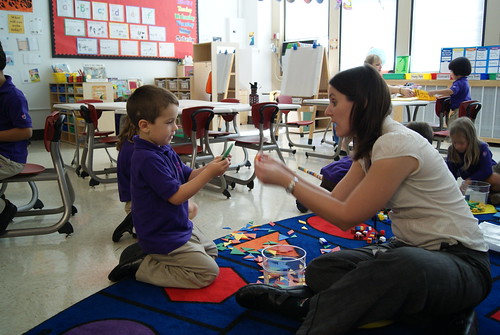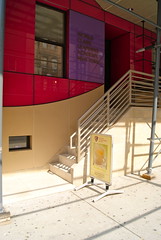 Hayley Roberts of World Class Learning Academy teaches her kindergarteners about shapes during play time.
Hayley Roberts of World Class Learning Academy teaches her kindergarteners about shapes during play time.Every day before and after school, John Taylor, headmaster of World Class Learning Academy, stands outside, greeting parents and waving goodbye to children.
“I know it’s a bit old fashioned, but it’s still kind of nice,” he said.
It may be the only thing that’s old-fashioned about this new private school. After commandeering two-thirds of the old La Salle Academy building in 2010, the school “injected millions,” per Mr. Taylor, into renovating and modernizing the 75-year-old building at 44 East Second Street. On Sept. 6, it opened its doors to 32 students between pre-kindergarten and fourth grade. The bulletin boards in hallways and classrooms are already filled with their artwork and projects.
The lobby is fragrant with fresh flowers, its walls painted in the school’s colors, purple and pink. All of the bright, airy classrooms are equipped with SMART Boards. The cafeteria fits 70 students, and its full kitchen will start serving food this winter. On the two top floors, Mr. Taylor hopes to build art and music studios or student lounges for upper grades. There are even plans for a rooftop playground.
The academy is part of the World Class Learning Group, a series of British schools with locations in Boston, Chicago, Charlotte, Houston, and Washington, D.C. Its teachers are trained in the U.K. to use two curriculum models, the English National Curriculum and the International Primary Curriculum.
“The children are being taught to learn how to learn,” Mr. Taylor said. “We’re not teaching to the test.”
Students are encouraged to experience lessons rather than being lectured. Lessons are based on themes – recently, a “holiday” theme helped kindergarteners learn about different types of animals and food as they traveled to Kenya on virtual safari.
Hayley Roberts, a kindergarten teacher, came to the United States from South Wales and taught in World Class Learning Academy’s Houston and Chicago schools for six years before coming to New York. Ms. Roberts said that parents have told her their children don’t even realize they are learning, because the lessons are so engaging.
“I’ve been able to see how this works for so long that now I don’t think I could work at a school without this curriculum,” she said.
An international curriculum has increased in popularity with New York City parents, prompting the arrival of several similar new schools in recent years. And the students seem to like it too.
“I have nice teachers and friends and we have good work and we can do projects,” said Khadija, 7, a second grader.
Along with educating children in math, science and language arts, the school is focused on turning its young students into thoughtful citizens of the world that are prepared for the future.
“What you want is to grow a generation of children who are going to be there to assimilate to what the needs of the world are going to be, in order to face situations and challenges that will be before them,” Mr. Taylor said.
While the school has a strong international preoccupation, it also wants to be an active, important part of the local neighborhood.
“If you want to be in the heart of real culture, then you come to the East Village,” Mr. Taylor said. “You don’t necessarily head up to the Upper East Side. There’s a living culture here that you don’t get elsewhere in Manhattan.”
But the cost of admission may not necessarily be very East Village. Tuition can run almost $32,000 per year for each child. Still, Mr. Taylor said that price was reasonable: “Even including new student fees, it’s still a really good deal and you know with the quality of teachers and the quality of the facility, it’s probably the best deal in town.”
This post has been revised to reflect the following correction:
Correction: September 28, 2011
An earlier version of this post incorrectly stated that the school was on Fourth Street. It is on Second Street.




